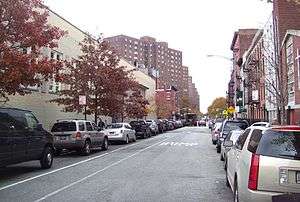Gashouse District


The Gashouse District or Gas House District was a name given to an area of the New York City borough of Manhattan which was dominated by giant gas storage tanks, or "gashouses", from the mid-19th century to the mid-20th century. The district was considered to extend from 14th Street to 27th Street and from Third Avenue (from 18th to 23rd streets) and Park Avenue South (from 23rd to 27th streets) to the East River.[1] The district was largely replaced by the giant Stuyvesant Town—Peter Cooper Village housing developments – the first buildings of which opened in 1947 – the remainder is now considered to be part of the Gramercy Park neighborhood.
History
The first tank was constructed in 1842 at East 23rd Street and the river,[1] and when numerous other tanks quickly joined it, the district received its name.[2] The tanks, which sometimes leaked, made the area undesirable to live in, as did the Gas House Gang and other predators who operated in the area. The population was predominantly poor, at first largely Irish, but then Germans and Jews as well; later, Slovaks and other Eastern Europeans were the dominant ethnic groups, including a large population of Armenians who lived in the upper Twenties between First and Lexington avenues.[1]
Crime in the district was endemic. When Alexander S. Williams was promoted to police captain and assigned to the area, he met the gangs' violence with equal force of his own, putting together a brute squad that beat up gangsters with clubs. He commented: "There is more law at the end of a policeman's nightstick than in a decision of the Supreme Court."[3]
With the construction of the East River Drive, now the "FDR Drive", the area began to improve. By 1939, all but four tanks were gone[1] and, while shabby, the area was no more blighted than many parts of the city after the years of the Great Depression.[1]
With the construction of Stuyvesant Town, the eighteen city blocks, with 600 buildings, containing 3,100 families, 500 stores and small factories, three churches, three schools, and two theaters, were razed. As would be repeated in later urban renewal projects, some 11,000 persons were forced to move from the neighborhood. In 1945, New York Times called the move from the site "the greatest and most significant mass movement of families in New York's history."[4] The last residents of the Gashouse district, the Delman family, moved out in May 1946, allowing demolition to be completed shortly thereafter.[5]
References
- Notes
- 1 2 3 4 5 Federal Writers' Project. (1939) New York City Guide. New York: Random House. ISBN 0-403-02921-X (Reprinted by Scholarly Press, 1976; often referred to as WPA Guide to New York City), pp.187-189
- ↑ "Huge Gas Tank Collapses". New York Times. December 14, 1898. p. 1. Retrieved 2010-07-20.
- ↑ Burrows, Edwin G. & Wallace, Mike (1999). Gotham: A History of New York City to 1898. New York: Oxford University Press. ISBN 0195116348., p.999
- ↑ Cooper, Lee E. (March 3, 1945). "Uprooted Thousands Starting Trek From Site for Stuyvesant Town". New York Times. p. 13. Retrieved 2010-07-18.
- ↑ "Last Tenant Vacated in Stuyvesant Town". The New York Times. May 5, 1946. p. 18. Retrieved 2010-07-18.
